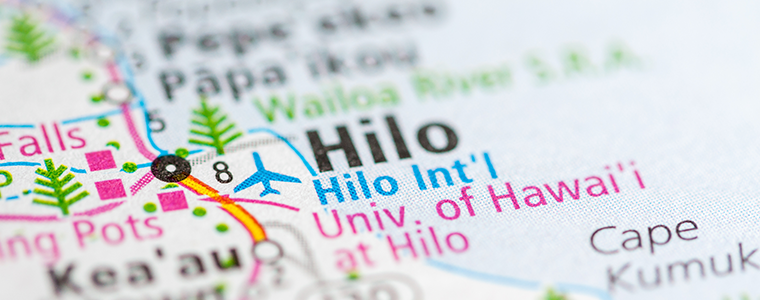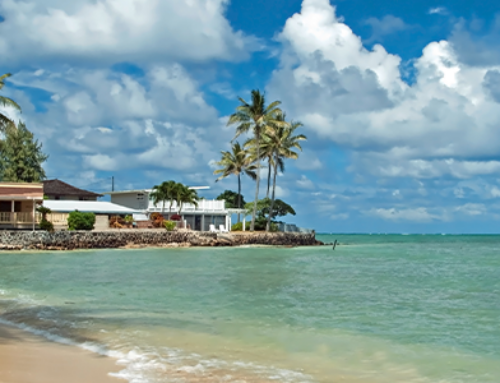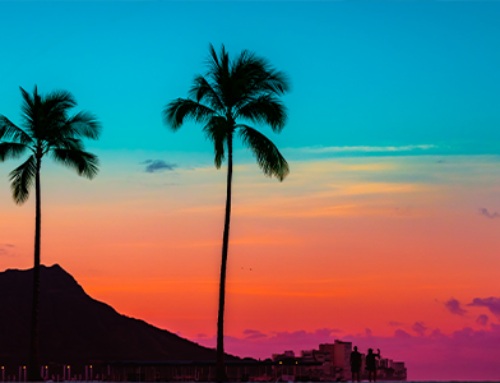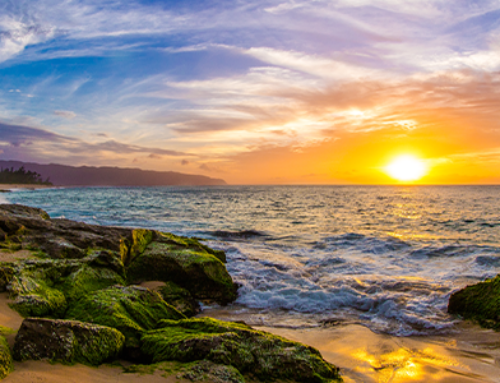You’ll find the town of Hilo on the eastern coast of the Big Island of Hawaii, nestled in the South Hilo district.
Many people will tell you that Hilo is the rainiest city in the U.S.i—but that doesn’t tell the whole story.
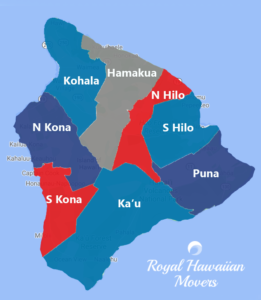 In fact, Hilo sits in the “tropical rainforest” designation of the Köppen-Geiger Climate Classification System. In other words, there’s no dry season in Hilo.ii As a result, the landscape in the North and South Hilo districts is one of the most verdant on the island. Think waterfalls and plentiful plant life in vibrant shades of greens, pinks, reds, yellows, purples—almost every shade imaginable.
In fact, Hilo sits in the “tropical rainforest” designation of the Köppen-Geiger Climate Classification System. In other words, there’s no dry season in Hilo.ii As a result, the landscape in the North and South Hilo districts is one of the most verdant on the island. Think waterfalls and plentiful plant life in vibrant shades of greens, pinks, reds, yellows, purples—almost every shade imaginable.
Additionally, Hilo holds the distinction of being the seat for the County of Hawaii, as well as home to the University of Hawaii at Hilo. The town is also the fourth-largest population center in the Hawaiian Islands.iii
If you’re considering a move to Hilo town – or one of the surrounding areas – you’re in the right place. We’ll walk you through everything you need to know to make a smooth transition to this tropical destination. (Or, if you’re still considering other areas of the Big Island, don’t miss our must-knows about moving to Kona.)
We’ll start with one of the most common questions we hear from potential residents.
Must-Know #1: How Much Does It Cost to Live in Hilo?
We’ll be straight with you: It’s expensive to live in Hawaii, as compared to the other states in the U.S. However, Hilo has a reputation for being one of the less expensive places to live in Hawaii. AreaVibes, HomeSnacks and Livability all named Hilo high on their lists of more affordable places to live in Hawaii. Lower home prices are one of the main factors that keep Hilo’s cost of living down. Take a look at this Zillow data comparing Hilo to some other popular Hawaii destinations:

Zillow Typical Home Value Data iv
That said, you’ll still find that everyday necessities like groceries and utilities will likely cost more than you’re used to. To help with the cost, Hilo has plenty of farmers markets. These can be a good source of fresh, local produce at better prices than you’ll see at the grocery store. You’ll also find a Costco in Kailua-Kona. Many residents make the drive to take advantage of the big box store’s deals. If you don’t want to journey all the way across the island, there’s also a Cost-U-Less in Hilo. Like Costco, this Canadian-owned warehouse store offers bargains on bulk buys.
The bottom line? Yes, Hilo is expensive. However, if buying a house is on your list of “musts,” Hilo offers a distinct advantage over other locations in Hawaii.
Must-Know #2: What Kind of Activities Will I Find?
Some consider Hilo the cultural center of the Big Island. Within the town of Hilo, you’ll find art galleries, boutiques, a book store, museums, restaurants, bars, and other attractions to keep you busy.
However, like the rest of the Big Island, Hilo really shines in terms of the access it offers you to Hawaii’s amazing outdoor wonders. Since you’ll be on the eastern side of the island, you’ll be surrounded by tropical rainforests, botanical gardens, and waterfalls, which you’ll find all up and down the coast. You’re also in close proximity to Volcanoes National Park, home to Kilauea, one of the world’s most active volcanoes.
Additionally, with a little driving, you’ll be able to enjoy everything that the Big Island of Hawaii is known for: hiking, beaches, watersports, off-roading, and many more outdoor activities.
To get you started, check out our lists of things to do in and around Hilo:
A guide to the the beauty and diversity of Hawaii’s plants and flowers in Hilo.
Enjoy the island’s natural beauty, history, work of its artists, and more.
Get ready to enjoy snorkeling, swimming, scuba diving, and even some small-scale cliff diving!
Must-Know #3: What’s the Weather Like?
We already discussed Hilo’s championship title for “Wettest City in the U.S.” However, what you may not realize is that the amount of rainfall can be dramatically different just a few miles away. For example:
- In downtown Hilo, the annual rainfall is about 146 inches.
- Eight miles north to Pepeekeo and you’ll see 155 inches of annual rainfall—even more as you head mauka (toward Mauna Kea).
- Eight miles west of Hilo, in the Hilo Forest Reserve, the annual rainfall is about 224 inches.v
Those are some big differences over a relatively small area. If you want to explore the mean annual rainfall in your new neighborhood, check out the Rainfall Atlas of Hawaii. Their interactive map will show you exactly what to expect.
Finally, when it comes to average temperatures, Hilo’s weather is consistent year-round. Expect lows between 64°F and 70°F and highs between 79°F and 83°Fvi. If you’re coming from an area with dramatic shifts between seasons, Hilo will feel like quite a change!
Must-Know #4: What Should I Bring? And What to Leave Behind?
Given the weather, the most important thing you’ll want to bring when you move to Hilo is an umbrella or a light jacket. Life in Hawaii doesn’t stop when it rains. (How would you enjoy the rainbows?) Having an umbrella or a rain shell in easy reach will keep you dry while you go about your business as usual.
Additionally, if you own a dehumidifier, bring it with you. Running it regularly in your closet or your bedroom can help keep any potential mold or mildew at bay. In terms of what not to bring, we always recommend downsizing before your move to Hawaii. In our experience, you’ll almost always need less than you think you will. Bring the basics, and get anything else you need after you arrive.
Must-Know #5: Where’s the Best Place to Live in Hilo?
It all depends on what you’re looking for. A good neighborhood for families? Peace and serenity? Easy access to Hilo town’s amenities? You’ll find a lot of great areas to live in and around Hilo. Your best bet is to match up your neighborhood with the kind of lifestyle you want to enjoy.
o get you started, check out the Insider’s Guide to Living in Hilo. We’ll share some of our favorite neighborhoods, as well as offer you some ideas for where to shop and how to spend your time off in the area.
One note on renting: You’ll find it much easier to score a rental once you’re already on island. We suggest securing temporary housing while you look for something more permanent. This will also help you avoid the occasional rental scams that pop up on Craigslist and Facebook. While these sites can be good sources for leads, never put down a deposit on a place that you haven’t seen first. This will help you avoid the majority of the schemes, which are fake rental listings featuring stolen pictures from real estate listings. Finally, if a deal seems way too good to be true, it probably is. Being on island and touring places in person will help you steer clear of these problems.
Must-Know #6: Can I Bring My Cat or Dog ?
Absolutely! Plenty of new residents bring their pets to Hawaii. However, because the Aloha State is a rabies-free location with a unique ecosystem, there’s a little more involved than in your usual state-to-state move.
We’ve broken down everything you need to know in this article: The Complete Guide to Moving Your Dogs, Cats, and Other Pets to Hawaii. We’ll give you the run-down on all the paperwork and procedures so you can bring your best buddy with you when you move.
If you have a pet that’s more exotic than a dog or a cat, make sure to check the Hawaii Department of Agriculture’s Plant Quarantine’s guidelines for importing animals. There are some surprising no-gos on the list, including ferrets, gerbils, and snakes.
Must-Know #7: Should I Ship My Car?
We get asked this question all the time! In our opinion, you’ll definitely need a car if you want to explore all that the Big Island has to offer. However, it’s important to recognize that shipping your vehicle is an investment in its future with you. If you plan to keep this car around, by all means, ship it to Hawaii. (And if it’s a truck with good clearance or a 4WD vehicle, it will serve you well on the Big Island, where off-roading is popular!)
On the flip side, if you plan to get rid of this car fairly soon, don’t ship it. Instead, bite the bullet and sell it where you are. Then, use the proceeds from the sale to buy a new or used car on the Big Island once you arrive. If you want to dive deeper into this topic, check out our article on shipping your car, truck, or SUV to Hawaii.
Before we close out this topic, a quick tip: People on the Big Island honk considerably less than people on the mainland. In fact, many people consider it rude. Unless you’re trying to alert someone to danger, lay off the horn. Drive with aloha. You’ll make a lot more friends in your new home that way.
Making Your Home in Hilo
The Hilo side has a lot to offer including charm and amenities of Hilo town; a lush, tropical landscape; and plenty of opportunities for outdoor adventures in the surrounding environment. Plus, with these seven insider tips under your belt, you’ll know exactly what to expect, positioning you for a smooth transition to your new home in Hilo.
If you’re headed for Hilo, we’d love to help you with a safe, easy, and affordable move. Our Hilo-based team does mainland moves, international moves, interisland moves, and local moves, so we can assist no matter where you’re starting from. Get started today with a complimentary quote from one of our experts.
Tell us about your move!
